Juno
Latest
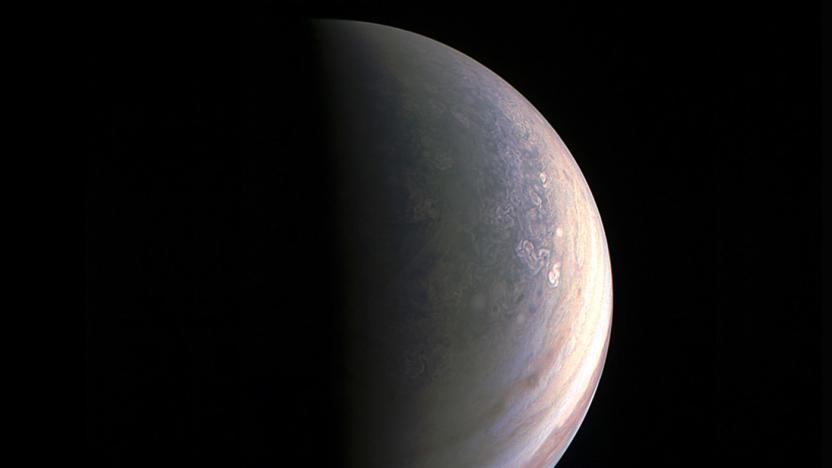
Juno sends back a rare view of Jupiter's north pole
When someone mentions the planet Jupiter, you probably think of the image we're all familiar with: that one with a view of its equator, bands and the Great Red Spot. That's why the photos above and below the fold might look like an alien world, when in reality, they're snapshots of the gas giant from a different angle. NASA's Juno spacecraft captured the planet's north polar region on cam two hours before its closest approach in late August. It was 120,000 miles away when the JunoCam took these pics, but it got as close as 2,600 miles above Jupiter's surface. The last time we caught a glimpse of the gas giant's polar region was back in 1974 when the Pioneer 11 probe passed by.

Juno probe makes the closest-ever encounter with Jupiter
If you thought the Juno probe's first photos of Jupiter were tantalizing, you're in for a treat. The spacecraft just completed the closest approach it will take during its primary mission around the gas giant, passing a mere 2,600 miles above the surface early on the 26th. It's the closest any vehicle has been to Jupiter, and NASA researchers already believe that they'll discover new things about the Jovian world once they process the data (which could take "some time," NASA warns). And of course, it's a prime photographic opportunity. You'll not only get the sharpest-ever photos of Jupiter's atmosphere when photos arrive late next week, but the first good look at the planet's poles.
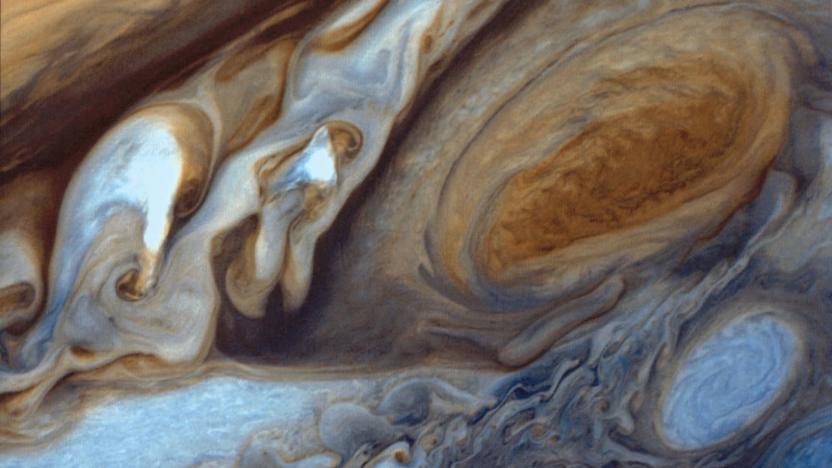
Researchers believe Jupiter's Red Spot is heated by thunder
Despite its distance from the sun, Jupiter is a surprisingly hot planet with temperatures ranging around 1,000 degrees Fahrenheit in the middle latitudes. According to new findings published today in the journal Nature, temperatures over the planet's Great Red Spot can range even higher -- up to about 2,500 degrees Fahrenheit, or 1,300 degrees Celsius. And the researchers behind the new study believe they may have finally figured what's feeding the extreme temperatures around the 10,000-mile-wide storm.
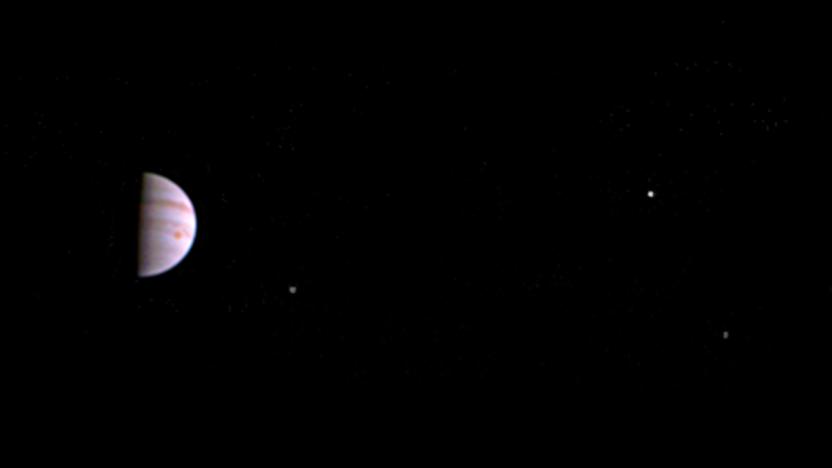
Juno sends back first photos from Jupiter's orbit
With Jupiter being some 365 million miles from Earth at its closest point, it can take awhile to send information from beyond the asteroid belt and back to Earth. On July 10th, just six days after arriving in Jupiter's orbit, NASA flipped on Juno's main visible light camera "JunoCam" and started snapping pictures. Now, just a couple days later, and we've got JunoCam's first shots of the largest planet in the solar system.

Juno has begun its tour of Jupiter after a five-year journey
Juno's five-year journey has come to an end, and soon, it will start taking measurements and capturing images of the largest planet in our solar system. The spacecraft, which aptly carries Lego figures of the Roman god Jupiter, his wife the goddess Juno and Galileo, has entered Jupiter's orbit after firing up its engines before midnight and performing a 35-minute maneuver. That was much harder to accomplish than it sounds -- it had to be at the right speed to be captured by the gas giant's gravity, or it would have slipped right past it. In the end, everything went well, and the spacecraft's arrival was off only by a second.

How to watch NASA's Juno spacecraft enter Jupiter's orbit
NASA launched its Jupiter-exploring Juno spacecraft on August 5, 2011, but thanks to some patriotic timing, it's arriving at the gas giant today on July 4th. That'll give space fans some additional fireworks, as NASA and JPL will be broadcasting the crucial orbit insertion starting at around 10:30 PM ET. If all goes well, the craft will fire its main engine for 35 minutes and scrub 1,212 mph from its current 37,000 mph velocity. That'll give it just the right speed to be captured into a 53-day orbit around the planet.
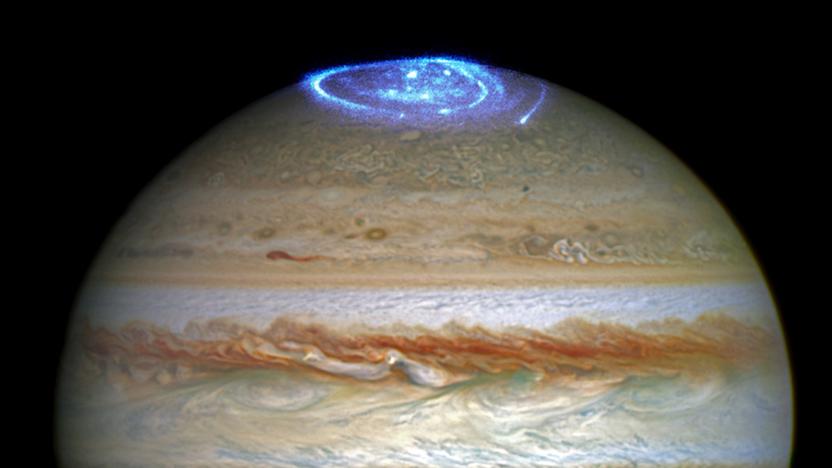
Hubble photographs Jupiter's dramatic auroras
The wispy, glowing veil sitting on top of Jupiter in the image above is actually a humongous aurora captured on cam by Hubble. A team of astronomers are using the telescope's ultraviolet instruments to study nature's light shows on the poles of the gas giant. They timed their study to coincide with Juno's arrival on the planet, since one of their goals is to determine how different solar wind conditions and other factors affect Jupiter's auroras. The spacecraft is in charge of measuring various solar wind properties, while they continue capturing images and videos almost every day during the duration of the mission.

Trent Reznor and Atticus Ross made a song for NASA's Juno mission
Nine Inch Nails frontman and Apple Music contributor Trent Reznor has another project with his film soundtrack partner Atticus Ross. This time around, the duo has created a nearly 9-minute track to celebrate NASA's Juno mission to Jupiter. The single song is available now on iTunes ahead of the probe's scheduled July 4th arrival in the planet's orbit. NASA's solar-powered spacecraft was launched five years ago, but soon it'll arrive at Jupiter to begin the task of measuring, studying and photographing the planet. For a behind-the-scenes look at the mission, check out our recent Juno feature.
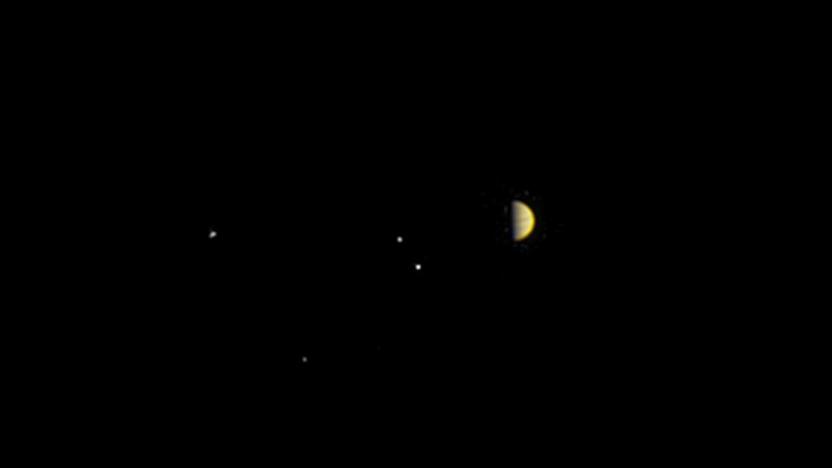
Juno snaps a pic of Jupiter before it reaches the gas giant
NASA's Juno spacecraft is diving into Jupiter's orbit in a few days' time, five years after it blasted off its launching pad in Cape Canaveral. The gas giant is merely a stone's throw away, and this image captured by the probe's camera, the JunoCam, shows just how close it is to reaching its destination. Juno took a photo of the planet and its four biggest moons on June 21st, while it was 6.8 million miles away. That might sound like it's still awfully far, but don't forget that the probe will have traveled 1.74 billion miles by the time it enters Jupiter's orbit on July 4th. JunoCam could only manage a hazy photo at that point in time, but you can still make out Jupiter's bands. You can also see four dots on one side of the picture, which are actually the Galilean satellites Io, Europa, Ganymede and Callisto.

Juno: An inside look at NASA's mission to Jupiter
Juno is going where no spacecraft has before. NASA's solar-powered ship was launched five years ago, sent on a mission to study Jupiter, the largest gas globe in our solar system. Now, after almost a couple thousand days on course, it is on track to arrive at Jupiter on the evening of July 4th to scan, measure, study and photograph the planet. On a recent trip to the Jet Propulsion Laboratory (JPL) headquarters in Pasadena, I caught up with lead project scientist Steve Levin for a rundown of the mission and the specific event that could potentially uncover the mysteries of our entire solar system.
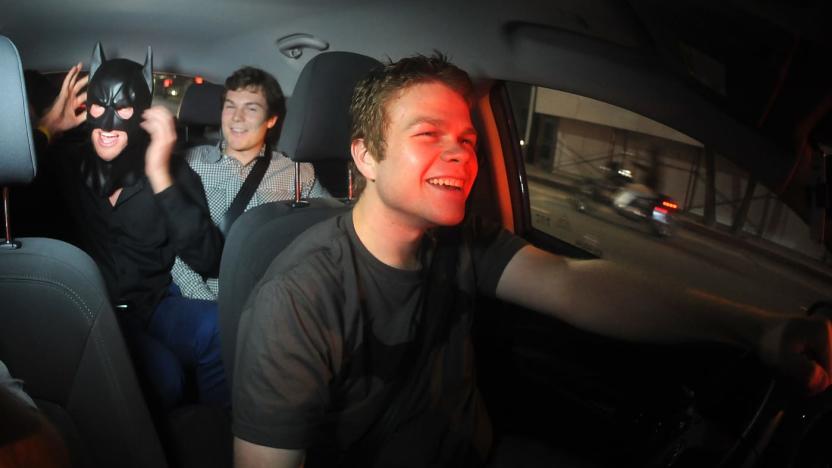
Uber rival promises a nicer ride through happier drivers
Numerous transportation outfits pitch themselves as anti-Ubers that aren't as relentlessly profit-minded as Travis Kalanick and crew, but Juno is trying something a little different: it's hoping that a mix of kindness and self-interest will win the day. The startup is launching a ride-hailing service in April that will not only focus on hiring better drivers (it's poaching some of Uber's highest-rated workers), but treating them well. They'll get more shares in the company the more they drive and the better their ratings. Think of it as the ridesharing equivalent to fair trade coffee, where the happier, more successful workers might translate to a better product.

Juno sets distance record for solar-powered spacecraft
Aided by its enormous solar array, NASA spacecraft Juno has set a record as the most distant solar-powered space explorer. The four ton "armored tank" craft hit 493 million miles yesterday on its way to Jupiter, passing Rosetta's 492-million-mile mark. With a 30-foot-long array and 18,698 solar cells, it's able to profit from what little sunlight hits it. "Jupiter is five times farther from the sun than Earth, and the sunlight that reaches that far out packs 25 times less punch," said Juno project manager Rick Nybakken.

NASA prepares its Jupiter probe for arrival
It's been a long time in coming, but NASA's Juno probe is finally close to reaching Jupiter. NASA reports that the spacecraft is "on track" to arrive on July 4th, 2016 (how American!), and that the ground crew is tweaking the flight plan to at once give Juno more time and complete tasks ahead of schedule. The ship's initial orbit is splitting into two in order to test instruments before the science gathering starts. Also, it'll take 14 days to complete an orbit rather than the originally planned 11. That will extend the mission from 15 months to 20, but it should both get basic mapping data sooner (8 orbits instead of 15) and offer more leeway in case the Jovian world's magnetism and radiation create havoc. Hopefully, all this extra work will ensure that scientists understand not just the beginnings of Jupiter and the Solar System, but also the behavior of gas giants around alien stars. [Image credit: NASA/JPL-Caltech]

Instagram debuts three new filters and emoji hashtags
The five new filters that Instagram released back in December have reportedly been such a hit with users, the company has unveiled three more retouching options: Lark, Reyes and Juno. According to Instagram's blog, Lark softens reds in favor of blue and green hues to highlight landscape shots while Reyes washes out the image as a whole to create a weathered and vintage feel. The Juno filter is geared more for portraits. It boosts warm tones and whites while adding a slight green tint to cooler colors.

Genome testing is now easy, fast and pretty
Genome testing gear doesn't get a lot of love. Like a lot of lab equipment, it tends to be ugly and unwieldy -- it's not designed with the same elegance as the smartphone in your pocket. Mercifully, the crew at Fluidigm appears to have solved those problems in one shot with its Juno genotyping machine. The Yves Behar-designed device is (dare we say it) pretty, and wouldn't look out of place sitting on a desk. It's also more intuitive, relying on a large, simple touchscreen interface instead of keyboards and tiny displays.

NASA's solar-powered Juno mission heads to Jupiter today, Orbiter finds water on Mars? (video)
NASA's Juno mission has been beset by delays for a while now, but the solar-powered excursion is finally scheduled to take off for Jupiter today, in the hopes of making history. Throughout the course of its five-year journey, the "armored tank" spacecraft will be powered exclusively by a trio of solar panels, each measuring nine feet wide and 30 feet long. Close to Earth, these panels will be able to generate 14 kilowatts of electricity, but as Juno ventures deeper into space, they'll crank out only 400 watts. Power, however, shouldn't be an issue, as NASA has outfitted the craft with energy efficient onboard computers, and has drawn out a route that will maximize its exposure to the sun. Juno should arrive at Jupiter by 2016 and, if all goes to plan, will ultimately travel farther than any solar-powered craft ever has. The agency expects their creation to set the record in April 2017, when it should be about 507 million miles away from the sun, eclipsing the 492 million mile mark likely to be set by Russia's sun-juiced Rosetta craft, in 2012. Meanwhile, closer to home, the Mars Reconnaissance Orbiter has just delivered new imagery of the Red Planet's mountains, providing perhaps the strongest evidence that water still flows there. The images reveal long, finger-like tendrils that extend down steep slopes, including the rims of craters. They appear during the summer and fade away once winter arrives, suggesting the presence of a volatile material. Researchers failed to identify water above ground, but speculate that briny water may be flowing underground. Launch past the break to see the images, in all their eight seconds of glory.

NASA set to send Juno 'armored tank' spacecraft to Jupiter
NASA is gearing up to send an "armored tank" spacecraft called Juno to Jupiter this month, after several delays and reschedulings. The environment that Juno is to face will be one of the most treacherous any spacecraft has ever endured -- so Juno has all sorts of special features, such as a radiation vault, a protective shield to protect it from Jupiter's insanely radiation-heavy environs. An invisible force field surrounds Jupiter (a less powerful one also surrounds our own planet) which is heavy with high energy particles to shield it from highly charged particles which shoot off the sun. The mission will result in Juno orbiting Jupiter, the largest planet in the Solar System, for 15 months. Scientists have also devised a route that should shelter the craft from spending extended periods of time in the harshest zones. Juno's trip will also be the first ever solar powered mission to Jupiter.

Sanyo Juno lands on Boost Mobile, channels Sprint's SCP-2700
If Boost Mobile's latest from Sanyo -- the so-called Juno -- looks familiar, it damn well better: it's nothing more than a rebranded SCP-2700. We're still having a hard time getting used to the fact that Boost is back into the CDMA game yet again (in a big way) with Sprint's acquisition of Virgin Mobile, and needless to say, the Juno doesn't have a trace of iDEN compatibility coursing through its electronic veins. The fairly light spec sheet includes a 1.3 megapixel camera, QVGA display, GPS, Bluetooth, speakerphone, and an address book capable of swallowing up to 600 contacts; it's available today for $99.99 contract-free in your choice of pink or blue.

Trimble introduces GPS-equipped Juno SB and Juno SC workforce handsets
Trimble might not be the first mobile manufacturer that comes to mind for average consumers, but those in the construction biz probably have it on speed dial. The outfit has just unleashed a new duo of rugged, field-ready handsets in the Juno series: the GPS-equipped Juno SB and Juno SC. Both units also feature WiFi, Bluetooth, a 3-megapixel camera, 533MHz processor, 128MB of onboard memory, microSDHC slot, 3.5-inch display and a battery good for at least a day of toiling; if you're looking for 3.5G data support, you'll need to select the SC for that. The pair runs on Windows Mobile 6.1 and is available now, though there's no public mention of pricing details.

Juno's Digital Copy causing headaches in Canada?
Apparently a number of Canadians who have purchased Juno in hopes of downloading a Digital Copy and hauling it around on the go are coming up empty handed. We're seeing reports of failed attempts to redeem the packaged code, resulting in error messages indicating that "This product is not available in the Canadian store." Initially, users were generally assuming the blame needed to be placed on Fox, but according to an e-mail reply from the Fox Digital Copy Support team, it indicated that "Apple [was] working" to fix the problem as quickly as possible. Any of you in the Great North dealing with the same issue? Have you seen this on more than just one occasion?[Thanks, Nick]







